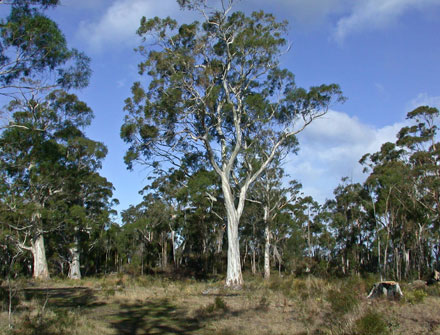
Extreme droughts could lead to widespread death of eucalypts from embolisms, researchers say. Source: ABC News
The trees cannot quickly adjust the size of their water transport vessels to cope with variability in water supply.
Their findings, published in this Ecology Letters, show the ability of eucalypts to transport water to their leaves has been “hard-wired” over long periods of evolution.
“This places eucalypts — and possibly other tree species — at risk from anticipated rapid changes in climate,” said the researchers, led by Dr Sebastian Pfautsch from Western Sydney University’s Hawkesbury Institute for the Environment.
Climate change is set to bring rising temperatures, more frequent heat waves and more droughts.
Since trees cannot migrate to get away from heat and lack of water, they rely on such strategies as dropping leaves and reducing evaporation of water from leaves to cope.
But the width of the vessels they use to transport water from the soil to their leaves also helps to determine how well they cope.
Narrow water transport vessels are better for trees growing in dry environments because a narrow vessel is less likely to form an air bubble (embolism) when insufficient water is available. Once an embolism forms in a vessel, the vessel is no longer able to transport water.
The question is how “plastic” the vessel width trait is — in other words, can trees adapt to drought by narrowing the width of their water vessels?
While there is evidence that some conifers narrow their vessel width in response to dry years, the latest findings suggest eucalypts cannot adjust like that.
“Our study in the diverse genus eucalyptus shows that vascular traits appear to be ‘hard-wired’,” Dr Pfautsch said.
Dr Pfautsch and colleagues studied more than 24,000 vessels in 28 species of eucalypt in Australia and found, as expected, that species adapted to drier parts of the country had narrower water transport vessels than those adapted to wetter conditions.
The researchers also measured vessels in a subset of species, which grew across a range of areas with different annual rainfall.
This analysis showed no difference in the width of vessels of any of these species, regardless of how much rainfall it was exposed to. This told the researchers that the width of the water vessels in eucalypts had a largely genetic basis.
Dr Pfautsch said eucalypts die once approximately 90% of their vessels contain embolisms, and if they cannot adapt their vessels in response to drought, they will be in trouble.
He said the current worst-case scenario is for temperature rises of 4 to 6 degrees Celsius by the end of the century.
“That is something that, in itself, will create a very different climate very rapidly and we would probably see that lots of trees would die.”
Professor Stefan Arndt from the University of Melbourne, who was not involved in the study, said scientists saw the Australian eucalypts as a “living laboratory” for studying how trees adapt to climate.
This is because they are a group of trees that are closely related and yet are adapted to very different environmental conditions.
He said Dr Pfautsch and colleagues were able to take advantage of this unique group of trees to show, for the first time, the influence of genetics on vessel width.
“This paper showed that … this is a very strong evolutionarily-determined signal that is based on the climate,” Professor Arndt said.
He said although mass tree death did not occur in Victoria’s drought between 1998 and 2010, there were already examples of mass death in Queensland and Western Australia.
After 20 years of drought in Western Australia, jarrah woodlands south of Perth endured mass forest collapse after the heat waves that occurred during 2010 and 2011.
Professor Arndt said although scientists were still studying why these trees died, he said it was most likely partly related to embolism because those trees often grew in rocky outcrops with shallow soil and low levels of water.
Combined with 20 years of drought, these conditions proved to be too harsh for the trees, he said.







